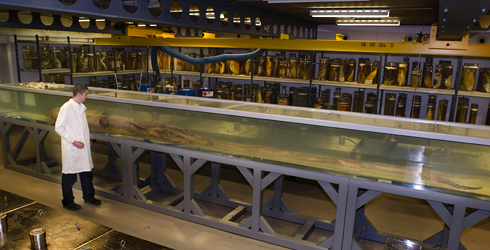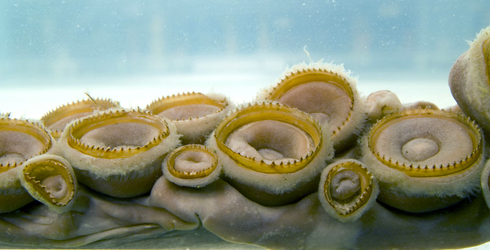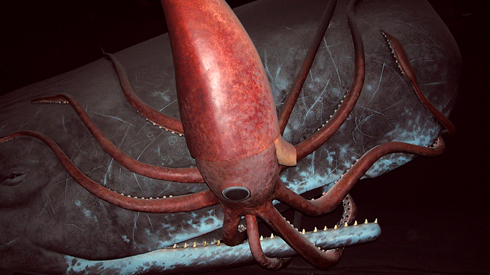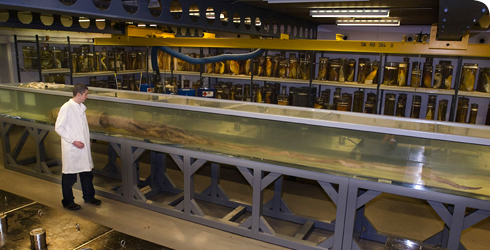Architeuthis dux (giant squid)
The giant squid, Architeuthis dux, was described by Steenstrup in Harting in 1860. It is the only species in the genus Architeuthidae.
Giant squid are the largest known cephalopod. Colossal squid (Mesonychoteuthis hamiltoni Robson, 1935) may reach greater lengths or mass but no complete, fully grown specimens have ever been recorded.
In the past, giant squid were often misreported as reaching lengths of up to 20 metres. Scientists now believe that adult females may only reach a total length of 15m, with adult males reaching up to 10m in length.
Most of the giant squid material in museum collections comes from specimens that have been found washed up on beaches or come from the stomach contents of sperm whales which feed on giant squid.
Museum specimen in focus

Museum scientist, Oliver Crimmen, measuring the giant squid
The specimen was caught:
- by the Falkland Island-registered trawler, John Cheek, on 15 March 2004 at 13:15.
- 15.6km (9.7 miles) north-west of Port Stephens Settlement, Falkland Islands, about 2km from the coast.
The ship's captain gave it to the research station on the Falkland Islands who donated it to the Natural History Museum on the provision that it was put on public display.
The specimen is:
- female
- 8.62m long, with a mantle length of 1.94m
- stored in a 6% formol-saline solution in the basement of the Darwin Centre's Zoology spirit building
It can be seen on a free guided Spirit Collection Tour.
-

Sightings
Get information about the first photographs and video footage of a live giant squid, including when, where and how they were taken.
-

Morphology
The giant squid has a beak that it uses to kill its prey and tear it into pieces small enough to digest. Find out more about the form and structure of Architeuthis dux.
-

Distribution and habitat
Find out which oceans and areas the giant squid is known from, as well as its predicted vertical range.
-

Locomotion, feeding and predators
Learn how the giant squid moves itself, and find out about its predators and prey.
-

References
Get reference material for Architeuthis dux.
Images

The Museum's 8.62-metre-long giant squid specimen in its tank in the Darwin Centre.

Giant squid specimen encased in ice at Melbourne Aquarium © Fir0002/Flagstaffotos (GFDL license http://www.gnu.org/licenses/fdl.html)

Giant squid tentacle with suckers.

Moving the Museum's giant squid specimen into its tank in the Darwin Centre. This Architeuthis dux specimen was captured off the coast of the Falkland Islands.

A fabled encounter between a sperm whale and giant squid, depicted in a diorama at the American Museum of Natural History © Fritz Geller-Grimm / Wikipedia

Architeuthis dux specimen in its tank in the Museum's Darwin Centre.
About the author
Useful resources
- Ellis, Richard. The Search for the Giant Squid. The Lyons Press.
- Norman, Mark. Cephalopods: A World Guide. ConchBooks.
- The Octopus News Magazine Online
Toolbox
Creatures of the Deep book

Go on an incredible, interactive 3D journey through the deepest ocean layers.
The book is fully illustrated and has pop-ups, fold-out landscapes and other interactive features.

